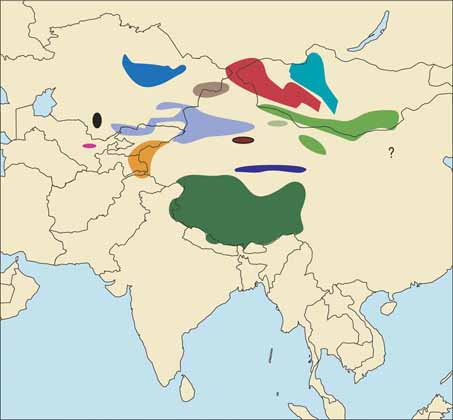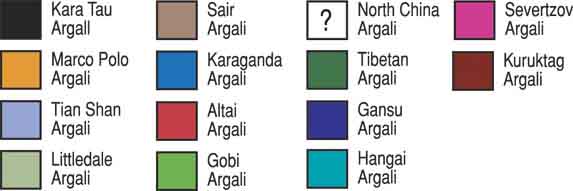 |
 |
Ovis ammon ssp.
The Hangay argali category was established in 1997 for record-keeping purposes. It is not a recognized subspecies (at least not yet), but is a distinct population in Mongolia that is neither Altai nor Gobi, as it is located a good distance east of the Altai mountains and north of the Gobi mountains. Most rams to date have been taken on a 7,697-foot (2,346 m) mountain called Üshigin Nuruu or Öshgoglyn Ikh, depending on the map (both mean Öshig Mountain), which is the southernmost part of the Hangay range. Öshig Mountain is south of the town of Bayanteeg and north of Baruunbayan in South Hangay Province. Map coordinates are roughly 45° 30'N x 101° 30'E.
During the first half of the 1980s, many hunters took rams in this area, which was then advertised as the "mid Altai." They were told they were hunting Altai argalis that were a little smaller than those in the West Altai, but at lower prices. Then in the 1990s other hunters were taken to the same mountain to hunt what they were told were very large Gobi argalis at premium prices.
From a record-keeping standpoint, it is obviously impossible to have both Altai and Gobi argalis from the same mountain, because they are subspecies that will interbreed and produce fertile offspring, and because they exhibit no consistent morphological differences by which they can be told apart. For the Record Book, all argalis from this area must be the same category: either Altai argali, or Gobi argali, or something else. We decided to call them something else-Hangay argali-because body and horn size in this area is consistently smaller than in Altai rams, but larger than in Gobi rams and, furthermore, this area is neither Altai nor Gobi, but is part of the Hangay range.
DISTRIBUTION The range of the Hangay argali includes not only Öshig Mountain, but also the rest of the Hangay range to the north.
More precise boundaries are being studied, but have not been finalized as we go to press. For example, it has been proposed that 97°E longitude be used to separate the Altai argali on the west from the Hangay and Gobi argalis on the east, and that 45°N latitude be used to separate the Hangay argali on the north from the Gobi argali on the south. This is under consideration.
|





